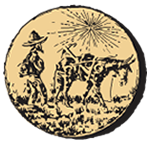Mining and Minerals Education Foundation |

Edward H. Wisser
(1895 -1970)
2000 Inductee from Mining's Past
Edward Hollister Wisser was born on July 28, 1895, at Fort Hamilton, New York. A combination of his military family heritage and his own service as a second lieutenant in World War I gave him a respect for order, discipline, and hard work that would typify his career. Wisser graduated from the University of California at Berkeley with a B.S. in Mining Engineering in 1917 and, after four years working as a mining engineer, returned to Berkeley for graduate studies. In 1926, he went to Pachuca, Mexico, and worked for Compañia Real del Monte y Pachuca, and was soon appointed Chief Geologist of Mexican operations for the company. He conducted mine mapping, petrographic studies, and exploration and property examination work throughout Mexico, including Sombrerete, Guanajuato, Santa Maria del Oro, Concepci6n del Oro, Matahuala, and Cinco Minas. His well thought out work leading to the discovery of rich silver ore deposits at Pachuca and Real del Monte in Central Mexico is particularly noteworthy.
In 1936, Wisser began to practice as an independent consulting geologist and, during the next 19 years, covered a wide variety of assignments for many different mining companies. He was associated with the discovery of major ore bodies within the mining districts of southern Arizona, Mexico, and the Philippines.
In 1946, Wisser became a Lecturer in Mining at Berkeley and then Professor of Mining in 1947. After retiring in 1962, he joined the Department of Mining and Geological Engineering at the University of Arizona as Visiting Scholar. He authored 22 papers during his academic career, including Geological Society of America Memoir 77, Relation of Ore Deposition to Doming in the North American Cordillera. His publications on economic geology and his writings on structural geology are timeless classics. Wisser was a successful ore finder, a dedicated teacher, and a tireless and successful student of the rocks and the geology of ore deposits. He strove throughout his career to impart his respect for order, disciplined field observations, and thoughtful presentation of data as a path to success, both to his profession and to his students.
